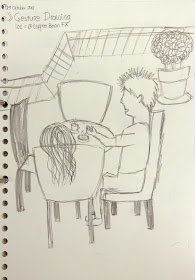A gesture drawing is work of art defined
by rapid execution. Typical situations involve an artist drawing a series of
poses taken by a model
in a short amount of time, often as little as 30 seconds, or as long as 2
minutes. Gesture drawing is often performed as a warm-up for a life drawing session.
In less typical cases the artist may be
observing people or animals going about normal activities with no special
effort to pause for the artist. For example, drawing from people on the street,
performers, athletes, or drawing animals at the zoo. More generally, a gesture drawing may be any drawing which attempts
to capture action or movement.
The primary purpose of gesture drawing is to
facilitate the study of the human figure in motion. This exploration of action
is helpful for the artist to better understand the exertions of muscles, the
effects of twisting on the body, and the natural range of motion in the joints. The practice allows an artist to draw strenuous
or spontaneous poses that cannot be held by the model long enough for an
elaborate study, and reinforces the importance of movement, action, and
direction, which can be overlooked during a long drawing. Thus, an approach is
encouraged which notes basic lines of rhythm within the figure. The rapidity of
execution suggests an aesthetic
which is most concerned with the essence of the pose, and an economy of means
in its representation, rather than a careful study of modeling of light on the
form.
For some artists, there is a calisthenic logic:
just as an athlete
warms up before exercising
or participating in sports, artists use gesture drawing to prepare themselves
mentally and physically for a figure drawing session. The fast pace of gesture
poses help an artist "loosen up" to avoid a stiff drawing style. The artist who undertakes gesture drawing also
receives the benefits of self-training their drawing ability. This kind of very
rapid drawing of the figure builds (through the act of frequent repetition) an
instinctive understanding of human proportions which may aid the artist when
executing more extended works.
For some artists, a gesture drawing is the
first step in preparing a more sustained work. Other artists, who seek to
capture brief moments of time in a direct manner, consider the gesture drawing
to be the end product. Drawing from life is often preferred over
photographic reference as it allows the artist to view the model from multiple
angles and without distortion of the lens or lighting. As well, the repetition
of short drawings without pausing forces the artist to work intuitively.
Drawings longer than two minutes are usually
not considered gestures, as they inevitability allow the artist more time to
measure and plan the drawing, or to begin to define the form with modeling.
Once the artist begins measuring, erasing, shading or otherwise improving the
drawing with a second pass, they have ceased to gesture draw and begun
rendering. They will be improving the complexity of their current drawing, but
they are no longer practicing their ability to draw correctly in from an
instant impression.
My exercise of gesture drawing :
After gesture drawing, i tried to draw my brother :D But I'm not really use gesture drawing technique.
 |
| Exercise. Model : My brother, Nicholas. |
 |
| Exercise. Model : My classmare, Grandy. |
 |
| Mr. Angga bought some fruits before we started the class and draw the fruits become next exercise. i used 2B pencil. |
Cheers,
JAJ


No comments:
Post a Comment